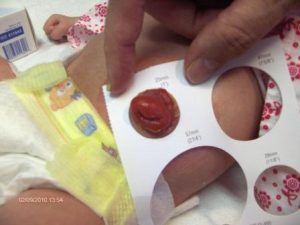Caring for a child with a stoma may have its challenges at times but the good news is that you are not alone.
Many children are born in Australia each year with conditions requiring the formation of a stoma, and almost all grow up to lead full and satisfying lives.
Caring for your childs stoma
Before your child leaves hospital, your Stomal Therapy Nurse will give you detailed instructions about how to care for, empty and change your child’s ostomy pouch. In Australia many ostomy product suppliers now offer a range of paediatric or mini pouches which will suit most kids and which are available through the Stoma Appliance Scheme.
As your child changes or becomes more active, his/her pouching system may need to change. In addition, as children grow, they may need a larger pouch or the addition of accessories. Your Stomal Therapy Nurse can help you to decide when to make these changes and what changes to make.
Your child’s pouch will need to be emptied when it is about one-third to one half full and may need to be opened often to release gas build up. Depending on the amount of gas, you may need to use an ostomy pouch with a filter.
If your child is an infant, it might be easier to empty the pouch if you angle the pouch to the side when you apply it. If your child is older and walking, angling it straight up and down is better for pouch filling.
It is always a good idea to empty the pouch before naptime and bedtime or before trips in the car. After emptying, wipe the bottom of the pouch before closing. A tissue or baby wipe works well for cleaning the bottom of the pouch.
How often you change yours child’s pouching system is influenced by your child’s level of activity and stoma output amongst a number of other factors. While its usual to change your child’s pouch every 1-3 days, your child can wear the same pouch for up to a week if the pouch does not leak and there is no rash or other redness on the skin around the stoma.
If your child’s pouch does leak, be prepared to change it as soon as possible to reduce the chance of him or her getting a rash from the stool touching their skin. Always make sure that you have plenty of supplies at home and always carry an extra ostomy pouch and any accessories such as wipes and paste when you leave your home just in case.
The skin around the stoma is called the peristomal skin and it is just the same as other skin on your child’s body. It is not more or less sensitive. Although the stoma has no feeling, the skin does. One of your most important goals is to keep the skin healthy. If the skin does not stay healthy, problems with pouch leaking may occur.
To clean the skin around the stoma use water or a cleaning wipe designed for use on peristomal skin. You may also use a mild soap that does not leave a film or residue on the skin and then rinse with plain water (soap and water will not hurt the stoma). It’s very important that you do not use baby wipes, oils, powders, ointments or lotions on the skin around the stoma as some products contain ingredients that can prevent the pouching system from sticking.
Broken skin, persistent redness or red bumps on the skin are not normal and it is best that you seek the advice of a Stomal Therapy nurse or other knowledgeable healthcare provider if you notice any of these on your child’s peristomal skin.
Participating in activity
When to get medical help
You can bathe your child with the pouch on or off. Water will not go into or harm the stoma. If your child has a urinary stoma, check with your child’s specialist before allowing the water to cover the stoma. If you decide to leave the pouch off while bathing, don’t be surprised if the stoma functions when in the tub. Avoid using oily soaps or lotions around the stoma because they can interfere with the barrier adhering to the skin. If your child wears a pouch when bathing, dry it off afterwards and check the seal for security
As you might guess from what you just read above, it is absolutely fine to swim with an ostomy. You are advised to use a pouch when swimming in a pool or lake. Larger swimsuits or a T-shirt can help cover up the pouch. Sometimes an ostomy belt or waterproof tape around the edge of the skin barrier can help make the pouching system more secure. The waterproof tape should be removed after swimming as it can irritate the skin.
When traveling on a plane with your child, be sure to pack your supplies in your carry-on luggage. In a car, your child should always be in a car seat. Avoid placing the seat belt over the stoma. When traveling, carry moist paper towels in a zip lock bag for easy clean up away from home. Remember, do not use commercially available baby wipes on the skin as they may leave a film on the skin and prevent a good seal.
The rate and timing of physical and development growth can vary greatly from child to child – even when they don’t have a stoma. When your child is ready, the stoma will not prevent him or her from normal movement. However, once they become more active, there will be more stress on the pouching system. You may need to make some adjustments in products, but the child’s natural curiosity and activity should not be discouraged.
Activity, even sports, need not be limited just because of the stoma. Consult your child’s doctor about any weight limits for lifting or activity in the early time after surgery.
Contact your Stomal Therapy Nurse if:
- Your child has a rash or other problems with the skin around the stoma
- The stoma pouch leaks a lot
- You have any questions about the stoma and/or stoma pouch.
Contact your child’s doctor if:
- Your child develops diarrhoea
- A lot more stool than usual collects in the pouch over a few hours
- Your child is unusually sleepy
- Your child is not producing urine
- Your child has a temperature of 38.5°C (101°F) or higher
- There is a major change in the stoma’s size or colour for more than a few minutes
- The stoma bleeds more than a small amount or will not stop bleeding
- Your child has less frequent bowel movements
- Your child is crying non-stop or otherwise seems to be in pain
- Your child’s belly becomes firm and bloated
- Your child has green vomit, even once.
Frequently Asked Questions
Can my baby take a bath?
Yes. You can bathe your baby with the pouch on or off. Water will not go into the stoma. If your
child has a urinary stoma, check with your child’s physician before allowing the water to cover
the stoma.
If you decide to leave the pouch off while bathing, don’t be surprised if the stoma functions
when your child is in the tub. After the bath, do not use any oily soaps or lotions around the stoma
that may interfere with the barrier adhering to the skin.
What should I use to clean the skin and stoma?
Gently clean the skin using something soft like a cotton ball, washcloth or paper towel moistened with water. It does not need to be sterile. If you use soap, be sure to rinse completely. Most baby wipes add moisture to the skin which interferes with the barrier sticking well, so they are not recommended.
Can I take my child swimming?
Yes. You are advised to use a pouch when swimming in a pool or lake. Larger swimsuits or a T-shirt will cover the pouch.
Do I have to feed my child a special diet?
A special diet may be required by other medical conditions, but not because of the stoma.
New foods can be added to your child’s diet as recommended by their physician. When a new food is added, it may change the color or consistency of your child’s stool or result in more gas. This is normal. Watch how they react to any new food. If it causes a problem with their output, consult your child’s specialist.
Can I breastfeed my baby?
Yes. Breastfeeding offers many advantages for both baby and mom. It is your choice.
Do I have to get certain clothes for my child?
You don’t need special clothes, but make sure waistbands don’t rub against the stoma. Some two-piece outfits may slide down and pull the pouch off, but they do make it easier to empty the pouch.
What if I smell an odour?
There should not be an odour when the pouch is on securely. If there is an odour, it usually means there is a leak in the pouching system or the spout of the pouch is not clean. Odour eliminators can help when the pouch is emptied or changed but check with your Stomal Therapy Nurse before adding any accessories to your child’s stoma care routine.
Can my child take medications?
Only give medications to your child that have been prescribed by their doctor. When starting a new medication, you may notice a change in his or her output. When filling a new prescription, tell your pharmacist that your child has a stoma.
They told us the stoma would be red. Sometimes it changes colour. Does that mean something is wrong?
Occasionally, the colour of the stoma will change. Sometimes, when a baby cries, the stoma becomes almost white. If the colour change is temporary – less than a few minutes – it is usually nothing to be concerned about.
My child has gotten older, and has now started pulling their pouch off. What can I do?
Children are naturally curious about their bodies and things around them. The pouch is no exception! It may help to dress your child in a one-piece outfit – even for naps. This can deter their exploration. A few toys in their cot can also help satisfy their curiosity.
My child pouch used to stay on longer. Is there anything I can do?
As your baby becomes more active, there will be additional stresses placed on the pouch seal. This is frustrating, but normal. When they start to scoot, crawl, pull themselves up on furniture and walk, the pouch may come off more often. You don’t want to limit this healthy activity. Your child’s Stomal Therapy Nurse may have some tips to help improve the seal.
The skin barrier we are using doesn’t seem to be working as well. Is there something I can do?
There are a number of things that can affect the skin barrier. In warmer weather, the skin barrier may not last as long. Changes in diet or a new medication may impact its effectiveness. Often, as babies start teething, parents notice a change in the stool. This can cause the skin barrier to wash away and not last as long as before. Most of these are temporary situations. If the problem persists, check with your child’s Stomal Therapy Nurse. They may be able to recommend a skin barrier that is more durable.
Can we travel?
Yes. Planning ahead is important for any trip. Be sure you have plenty of supplies. If you are flying, take your child’s stoma supplies in your carry-on luggage (remember to pre-cut if required and to stow scissors with your checked luggage). Changes in environment or routine may reduce the wear time of the pouch seal, so be sure to pack more than you think you will need. When in a car, your infant should always be in a car seat.
What about day care?
If you are planning to return to work, talk with your day care provider about your child’s stoma care needs and make sure they have plenty of supplies. You should teach several people how and when to empty the pouch. Plan how a pouch leak will be handled when you are not there.






